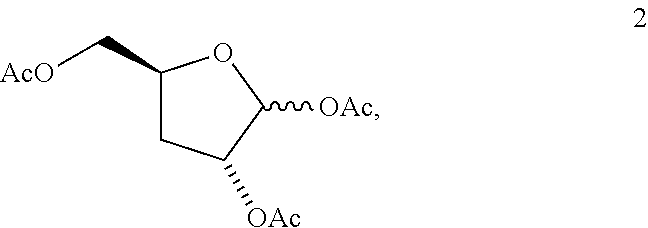Method of preparing deoxyribofuranose compounds
a technology of ribofuranose and ribofuranose, which is applied in the direction of sugar derivates, esterified saccharide compounds, organic chemistry, etc., can solve the problems of premature termination of a nascent nucleic acid molecule, gene expression or function disruption, etc., and achieves cost-effectiveness, efficient throughput, and high overall yield.
- Summary
- Abstract
- Description
- Claims
- Application Information
AI Technical Summary
Benefits of technology
Problems solved by technology
Method used
Image
Examples
example 1
Preparation of Compound (6) (Major) and Compound (7) (Minor)
[0061](a) Step 1: Formation of Tricycle Compound (5A)
[0062]A 4 liter 4 necked flask equipped with a nitrogen inlet, addition funnel, thermometer, and mechanical stirrer was charged with monoacetonexylose (152.16 grams, 800 mmol) and isopropylacetate (1200 ml) and stirred until the solids dissolved, yielding a slightly cloudy solution. Ketenedimethylacetal (3.36 ml, 35.5 mmol) was added and the reaction cooled to 3° C. using an ice bath. Methanesulfonic acid (0.52 ml, 8 mmol) was added followed by the dropwise addition of ketenedimethylacetal (80 ml, 844.5 mmol) over 45 minutes. The reaction temperature reached 10° C. during the addition. When the addition was complete TLC, using 80% MTBE in hexane, indicated a complete, clean conversion to the much faster running tricycle 5A. The ice bath was removed.
[0063](b) Step 2: Hydrolysis of Compound 5A to a Mixture of Monoacetates
[0064]Water (72 ml, 4000 mmol) was added all at once ...
example 2
Preparation of Compounds (8) and (9)
[0069]The 4 liter flask that already contains approximately 0.8 Moles of compound (6) in wet isopropylacetate from the previous step was equipped with a nitrogen inlet, thermometer, addition funnel and a mechanical stirrer. TEMPO (800 mg) was added and the mixture was stirred and cooled in an ice bath. In a separate flask an aqueous solution containing 64.3 grams of sodium bromide, 98.4 grams of sodium acetate dissolved in 320 ml of deionized water was cooled to 5° C. When the reaction temperature reached 5° C. the pre-cooled aqueous solution was added to it to form a biphasic reaction mixture. To this cold solution was added dropwise 735 ml of aqueous sodium hypochlorite solution (titrated directly before use, 10.15% or 1.36M, 1.002 Moles, 1.25 equivalents) over 2 hours, keeping the exothermic addition at or below 7° C. When the addition was complete stirring was continued for 30 minutes and the TLC (80% MTBE-hexane) indicated a complete conversi...
example 3
Preparation of Compound (10)
[0072]
[0073]A 4 liter 4-necked flask equipped with a nitrogen inlet, powder funnel, thermometer, and mechanical stirrer was charged with the cloudy organic solution of ketone (8) and its hydrate (9). This was cooled while stirring to 4° C. using an ice bath. To this cold solution was added four 42.4 gram portions of solid sodium triacetoxyborohydride in 15 minute intervals. After the final addition the reaction was stirred at 5° C. for 60 minutes.
[0074]While stirring at 5° C. 1.0 M aqueous sodium carbonate solution (800 ml) was added quickly. The reaction temperature rises to 12° C. and a small amount of gas evolution occurs. The mixture thickens substantially. After stirring 15 minutes the reaction is transferred to a 4 liter separatory funnel and the phases split, the aqueous portion contains some solid. The organic portion was stirred with 2.0 M aqueous sodium carbonate solution (400 ml) for 10 minutes, the phases split and both aqueous phases were com...
PUM
 Login to View More
Login to View More Abstract
Description
Claims
Application Information
 Login to View More
Login to View More - R&D
- Intellectual Property
- Life Sciences
- Materials
- Tech Scout
- Unparalleled Data Quality
- Higher Quality Content
- 60% Fewer Hallucinations
Browse by: Latest US Patents, China's latest patents, Technical Efficacy Thesaurus, Application Domain, Technology Topic, Popular Technical Reports.
© 2025 PatSnap. All rights reserved.Legal|Privacy policy|Modern Slavery Act Transparency Statement|Sitemap|About US| Contact US: help@patsnap.com



